
Counterfeit Lincolns
In the Lincoln cent series, there are some "key dates" that are worth considerably more money to collectors than more common dates. These are the most common counterfeited Lincoln cents: 1909-S V.D.B. 1914-D, 1922 plain (no mint mark), and the 1931-S.
Counterfeiters are very skilled at creating fake rare coins. They can sometime even make them appear worn and aged like an unsuspecting collector might expect a genuine coin to look like.
There are some well know markers to look for when detecting counrfeit coins. Shown below is the reverse side of a counterfeit 1911-S Lincoln cent. The die chip on the left wheat stalk, pointed out by the white arrow, is a sure marker that the coin is a fake. This same reverse is used on other dates as well.
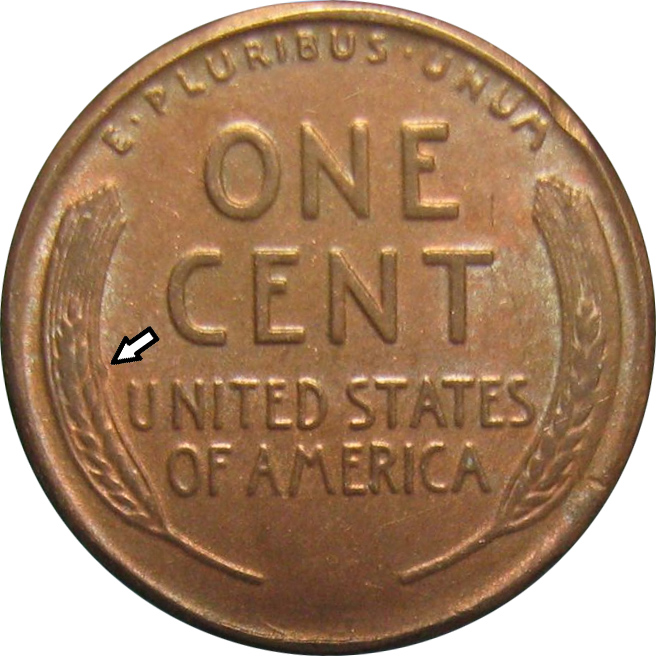
Images Courtesy of Paul Bulgerin
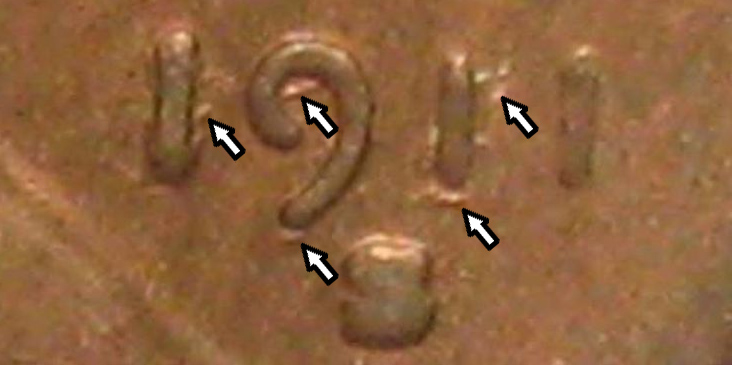
Other die chips on known 1911-S counterfeit Lincoln cents are pointed out in the photo above.
Counterfeit 1914-D
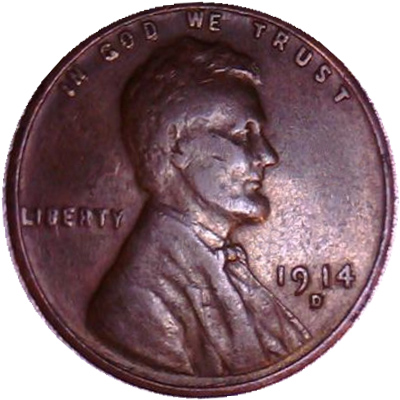
Look carefully at the distance between the digits of the date. On the example shown, you can see how the second 1 is much closer to the 4 than it is to the 9.
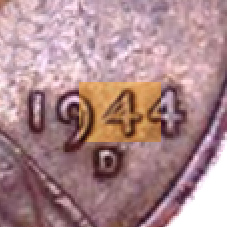
In this overlay of a 1944-D cent, you can see how the first 4 in the date was changed to a 1 creating this counterfeit 1914-D cent. A genuine 1914-D Lincoln cent will not have the designers initials (V.D.B.) under the shoulder of Lincoln's bust.
The elusive 1943 Copper cent.
In 1943, the composition for the Lincoln cent changed to Zinc plated Steel. There were estimated to be only 40 of 1943 cents struck on a Copper planchets by mistake. Some believe this may have happened as a result of the previous year's planchets remaining in the hopper when production of the 1943 cents began. This mistake happened at all three US mints, so there are 1943, 1943-D, and 1943-S Copper cents in existence. They are highly sought after by collectors and have reportedly sold for more than $1,000,000.00.
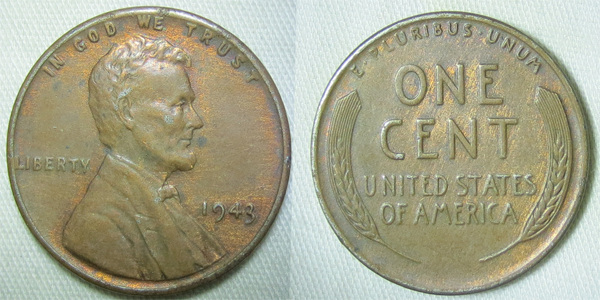
The photo above shows one that has been Copper plated, so it is a counterfeit 1943 Copper cent. The easiest way to tell if you have a true Copper cent or a plated one, is to test it with a magnet. A magnet will be attracted to Steel and stick to the coin if it is only plated. If you find one that a magnet does not stick to, you could have a the real thing, but counterfeiters have also been know to alter the dates of other Copper cents to look like a 1943 Copper cent. The most common dates used for this are 1948 and 1949.
Approximately 35 1944 Steel cents also exist and are also very sought after coins. Collectors speculate this also happened by the same mistake of Steel planchets from the previous year (1943) being accidentally left in the hopper when production of the 1944 cents began.
Counterfeiters have also found a way to fake these as well. There are some 1944 Copper cents floating around that have been plated with Steel. If you find one, the first step would be to use the magnet test, Steel is magnetic but Copper is not. If it is Steel, it will stick to the magnet. If it passes that test, weigh the coin in question. The normal weight of a 1943 Steel cent is 2.67 grams, vs 3.11 grams for a Copper cent. If your 1944 Steel cent weighs close to 2.67 grams, and is magnetic, you may have something!
Some 1943 Steel cents have been reprocessed by adding a new Zinc plating to them to make them appear uncirculated. These have no added value to collectors.
Fake Clipped Planchet Error
Below is a coin that was first thought to be a double clip, but when compared to the webbing it would be impossible.
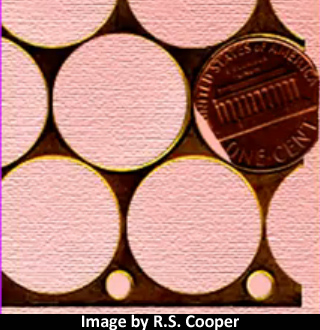
On post 1982 cents, faked clipped planchets can sometimes be identified by the lack of plating on the clipped edge.
FAUX TRIPLE STRIKE
Pictured below is a real 1964 Lincoln cent over struck by false dies. So this is NOT a genuine mint error, but one that has been faked.
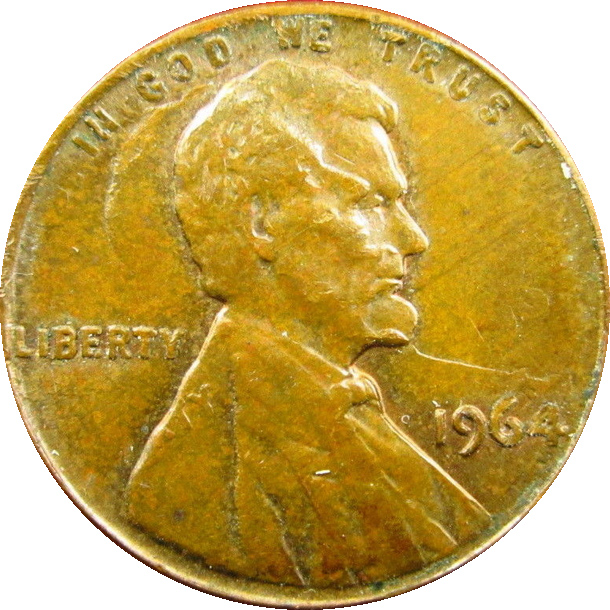
Photo By Geoffrey Noe
Unplated Cents
Removing the Copper plating from newer cents (1982-current) is a common way of counterfeiting an un-plated cent to sell to an unsuspecting collector. Learn the warning signs to look for.
A genuine unplated Zinc cent will shown some mint luster and the surface will be smooth and flat. On a plated cent that has had the plating chemically removed, the surface will be rough and gray colored.
Daniel Carr & Fantasy Coins
Since the definition of a coin is a piece of metal minted and issued by a government for use as money, the Daniel Carr coins techincally aren't coins at all, but instead would be considered tokens or medals.
Daniel Carr is the owner of the Moonlight Mint and also the designer of the actual New York and Rhode Island state quarters for the US Mint.
Fantasy coins are just that, fantasies. They are coins that don't exist or were never minted by a government. Some examples would be a 1910 Indian Head cent or 1915 Winged Liberty dime. Some of these coins are struck over genuine US minted coins, so they appear to be genuine. Since these coins were never minted, the fake coins aren't required to be labeled "COPY". An unsuspecting amature collector could stand to lose a great deal of money by thinking these were genuine rare coins. A good example of how a collector could be fooled is the 1922 plain Lincoln cent. Since the mint in Philadelphia never minted any plain cents in 1922, non were issued. As we all know, there are rare genuine 1922 plain Lincoln cents in existance, minted by errors. Some may have been from an over polished die or a filled die, but they are all real. There are also fantasy 1922 plain cents floating around and since there were none purposely minted by the government, they aren't required to be stamped "COPY"
Another example of a fantasy coin that could possibly fool a novice collector is the 1910 VDB cent. It is rumoured that there could exist a few genuine 1910 Lincoln cents with the initials VDB on the reverse side, caused from dies being reused from 1909 that didn't have the initals completely removed.